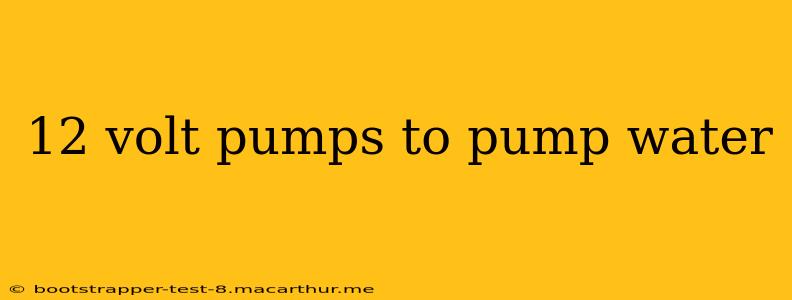Choosing the right 12-volt pump for your water pumping needs can feel overwhelming. With so many options available, understanding the different types and their applications is crucial. This guide will help you navigate the world of 12-volt water pumps, covering various types, applications, and factors to consider before making a purchase.
What are the different types of 12-volt water pumps?
Several types of 12-volt pumps cater to diverse water pumping needs. The most common include:
-
Submersible Pumps: These pumps are designed to be submerged directly in the water source. They're ideal for wells, ponds, and other submerged applications, offering efficient and quiet operation. Their compact design makes them suitable for tight spaces.
-
Centrifugal Pumps: These pumps use centrifugal force to move water. They are relatively high-flow pumps, making them suitable for larger-scale applications like irrigation or supplying water to a house. However, they are generally not as efficient as submersible pumps when dealing with smaller volumes of water.
-
Diaphragm Pumps: These pumps use a flexible diaphragm to pump water. They excel at handling thicker liquids or those containing solids, making them suitable for applications where other pumps might struggle. They're often chosen for their self-priming capabilities, meaning they can draw water from a source without needing to be initially submerged.
-
DC Peristaltic Pumps: These pumps use a flexible tube and rollers to move water, offering gentle and precise flow control. They're ideal for applications where gentle handling is crucial, like transferring delicate chemicals or aquarium use.
What are 12-volt pumps used for?
The versatility of 12-volt pumps makes them suitable for a wide range of applications, including:
-
RV and Marine Applications: Providing fresh water for sinks, showers, and toilets in RVs, boats, and caravans.
-
Irrigation Systems: Delivering water to gardens and agricultural fields, often powered by solar panels for off-grid solutions.
-
Water Features: Supplying water to fountains, ponds, and other decorative water features.
-
Livestock Watering: Providing a reliable water source for animals in remote areas.
-
Emergency Water Supply: Acting as a backup water source in case of power outages.
How do I choose the right 12-volt water pump?
Selecting the appropriate 12-volt water pump requires careful consideration of several factors:
-
Flow Rate (GPM): This refers to the volume of water the pump can move per minute (gallons per minute). Choose a flow rate appropriate for your needs. A higher GPM is required for larger-scale applications.
-
Head Pressure: This indicates the maximum vertical distance the pump can lift water. Consider the vertical distance between the water source and the point of use.
-
Power Consumption: Examine the pump's power draw (measured in amps) to ensure it's compatible with your power source and doesn't overload your battery or inverter.
-
Self-Priming Capability: Some pumps require being initially submerged, while others (like diaphragm pumps) can self-prime, simplifying installation and operation.
What is the difference between a 12V DC and 12V AC pump?
This is a crucial distinction. 12V DC pumps operate directly from a 12-volt DC power source, like a car battery or solar panel. 12V AC pumps, on the other hand, require an inverter to convert AC power to DC power before they can operate. Most applications utilizing car batteries or solar panels will require a 12V DC pump.
How much water can a 12-volt pump move?
The amount of water a 12-volt pump can move depends on several factors including the pump type, its flow rate, and the head pressure. The specifications provided by the manufacturer will clearly outline the pump's capabilities.
How long will a 12-volt pump run on a battery?
The runtime of a 12-volt pump on a battery depends on the pump's power consumption (amps) and the battery's capacity (amp-hours). A higher amp-hour battery will provide longer runtime.
This guide provides a comprehensive overview of 12-volt water pumps. Remember to always consult the manufacturer's specifications before purchasing to ensure the pump is suitable for your specific needs. Proper selection and installation will ensure efficient and reliable water pumping for your application.
